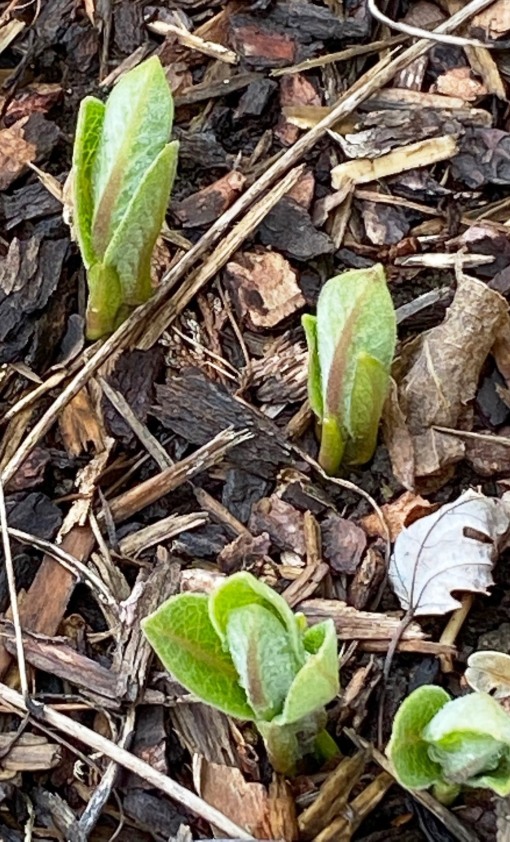
These are some crazy times lately. Snow in the second week of May just adds to the disruptions in our lives right now. Folks are looking to their yard and gardens to bring stability to the upheaval in their lives, and snow and cold weather does not ease the mind. However, mother nature has a way of healing the plants and in doing so, shows us we will heal, too.
Some blossoms will sustain damage without the entire plant being lost. Some plants will succumb to the freeze, but these plants are ones that grow naturally and natively in much warmer areas which would not experience snow or freezing weather. If tomatoes or marigolds were planted out in the garden, they most likely were killed from the freeze. See packets and transplant labels state to wait to plant after all danger of frost has passed. For us in Connecticut, May 15th is the average last frost date. I err on the side of caution, waiting until Memorial Day when the soil as warmed considerably before planting cucumbers, peppers, petunias, squash and tomatoes. Putting these plants into cold soil will shock and stunt them for the rest of the growing season.
Perennial plants in our area are like old friends, returning home after a long absence. The familiarity of finding them in walk abouts, makes the world seem normal. Even some stalwart rhubarb laden with snow gives me hope we will weather our storms. Rhubarb is a hardy perennial vegetable, providing pies and baked goods from its leaf stalk. Don’t eat the leaves as they contain a high level of oxalates the body doesn’t handle well. Better to use the leaves in the compost or lay them on the ground in the vegetable garden to keep the weeds down. They cover a lot of area.
 Earlier in the week, I removed a flowering stalk from the rhubarb plant, to conserve the plant’s energy by not producing seed. Removal of the flower helps the clump grow bigger and get stronger.
Earlier in the week, I removed a flowering stalk from the rhubarb plant, to conserve the plant’s energy by not producing seed. Removal of the flower helps the clump grow bigger and get stronger.

Cut the rhubarb flower stalk at the base of the plant and compost it or use it in a flower arrangement.
Lilacs are a long-lived, woody shrub capable of with-standing freezes and snow. The flower buds were encased with ice and snow, but should bounce right back; only time will tell. The plant itself can live for over 100 years!

Magnolia is another woody tree that lives a long time, but its flowers are often damaged by frost and cold weather. The photo below was taken before the snow but after a frost, of Magnolia x soulangeana, showing the damage to the open blossom and the newly opened flower that was in bud at the time of the frost. After today’s snow, the petals have all fallen.
Flowering quince is a hardy shrub tolerant of late freezes. Its scarlet flowers didn’t blink with a covering of snow, shaking them off to shine brightly by noon once the sun came out. Each blossom should be appreciated up close for its rose like shape. Unfortunately, it is a pretty scraggly and unkempt specimen the rest of the year. She reminds of a disheveled and gangly teenage boy that cleans up nicely for prom, but only once a year.

Clove current is blooming, and before the snow released its spice scented aroma to soft wind. Hopefully, once the warmer weather returns so will the shrub’s offering to those in backyard.

I spoke of plants returning like old friends, expecting nothing from you except your company. They don’t try to change you or bring you around to around to their new found way of processing the world. Plants would never talk politics with you. They are just happy with your company. I think people could take a lesson or two from plants. Even weeds are consistently reappearing, each in their own time bringing a sense of comfortable familiarity. Chickweed has arrived, budded up with blossoms open in sunnier spots.

Bedstraw aka catchweed is entwining the old-fashioned shrub roses rescued from a 1600’s cemetery on Cape Cod. The paving truck was laying an asphalt walkway right over the rambling mass of thorny branches. I had to at least save a few in the way of its destructive path. The bedstraw always appears only in these bushes, making me think they must be old friends, too. I pull a few but don’t have the heart to remove them all, plus I like their airy foliage mixing with the deep pink roses once they bloom in June.

Milkweed shoots are up, promising a food source for many caterpillars and other insects. The monarch butterfly used milkweed species exclusively on which to lay eggs and for its larva. Common milkweed can become weedy as it spreads via seed and root, enlarging its colony each year.

I hope you find the return of old friends in the garden and maybe add a few new ones this season.
-Carol Quish
May 10, 2020 at 10:44 pm
Goodness, this weather has been in the news.